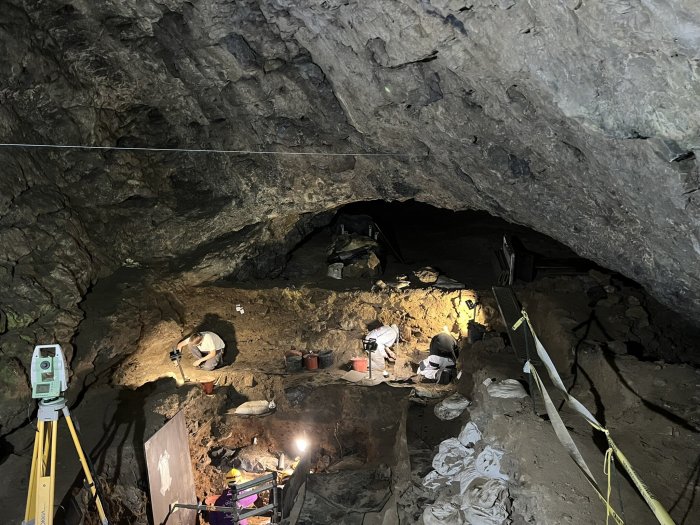Conny Waters – AncientPages.com – Archaeologists from the University of Liège are currently engaged in a new excavation campaign at the Paleolithic site of Trou Al’Wesse in Modave, Belgium. This remarkable site offers crucial insights into the settlement patterns of the first Homo sapiens populations in northwestern Europe approximately 40,000 years ago. Additionally, it serves as a practical training ground for archaeology students, providing hands-on experience.

Scientists and students during excavations inside Trou Al’Wesse. Credit: T. Libois, ULiège
Located within a secluded nature reserve on the right bank of the Hoyoux River, Trou Al’Wesse cave is an archaeological treasure of significant importance. Situated at the base of a limestone spur in Modave, this cave is being scientifically excavated by the Prehistory Department at the University of Liège, in collaboration with several partner institutions, including the University of Bordeaux.
The cave has been known to archaeologists since the 19th century and was initially explored by paleontologist Philippe-Charles Schmerling in the 1830s and later by Edouard Dupont in the 1860s. Dupont discovered ‘bone levels’ rich with remains from extinct fauna like reindeer and mammoths, intermingled with stone tools crafted by Paleolithic humans.
“These initial excavations, carried out at a time when archaeological methods were still rudimentary, yielded material without any precise stratigraphic context,” explains Damien Flas, archaeologist at ULiège. “Much of the objects collected were lost over time.”
In the late 1980s, a significant development occurred when the University of Liège resumed its research efforts. Although earlier excavations had disturbed the cave’s interior, evidence of prehistoric habitation was discovered outside. It wasn’t until 2003 that deeper surveys uncovered intact sedimentary deposits, leading to a series of significant findings.

Ivory bead showing the perforation, traces of work and red dye residue. Credit: Solange Rigaud, University of Bordeaux, CNRS—PACEA
Since then, archaeologists have discovered artifacts linked to the earliest Homo sapiens populations who settled permanently in northwestern Europe around 40,000 years ago. These include flint tools, reindeer antler spearheads, and fragments of mammoth ivory objects, such as a bead and engraved pieces.

Students during excavations inside Trou Al’Wesse. Credit: University of Liège, V. Rots
These items reflect the influence of the Aurignacian cultural complex, recognized as the first primary culture of the European Upper Paleolithic era. Carbon-14 dating tests have verified that these objects are over 35,000 years old.
See also: More Archaeology News
“These discoveries shed light on a key period in human history, marked by the emergence of the first forms of art, such as the famous Chauvet cave paintings and the ivory statuettes of the Swabian Jura, and the first musical instruments,” explains Veerle Rots, archaeologist and director of the TraceoLab at ULiège. They enrich an already remarkable regional corpus, alongside the iconic sites of Spy and Goyet.”
Beyond their scientific significance, the Trou Al’Wesse excavations are also a valuable training ground, where archaeology students from the University of Liège, as well as from universities in Brussels, Toulouse and Bordeaux, are trained every summer.
Science paper
Written by Conny Waters – AncientPages.com Staff Writer









